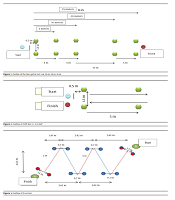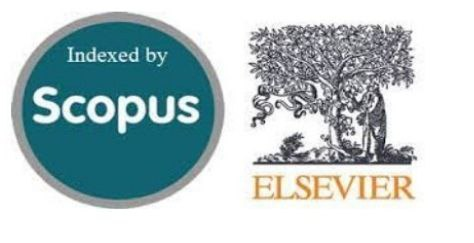Effects of Plyometric Training on Lower Limb Strength and Power in Young Postpubertal High Level Basketball Players
Keywords:
Plyometric Training, Peak Height Velocity, Adolescent, Basketball, PerformanceAbstract
Background: Currently, the scientific evidence available on plyometric training in young basketball players is limited. Objectives: The aim of this study was to analyze the effects produced by plyometric training over a period of 8 weeks, with a frequency of two weekly training sessions, combining vertical and horizontal force vectors. Methods: The study involved 28 young men (14.54 ± 0.6 years, a height of 182.76 ± 7.1 cm and a body weight of 68.05 ± 9.8 kg) high-level basketball players and aimed to investigate the effects of this training program on athletes at different maturational states, specifically based on their peak height velocity (PHV) and post-pubertal (post-PHV) stages. Results: Substantial improvements were achieved in the subjects who have carried out this type of plyometric training in all the parameters evaluated related to the improvement of the jump, linear speed and change of direction. Conclusions: Therefore, it is crucial to provide valuable information to trainers and physical trainers, enabling them to improve and individualize the conditioning work for optimal performance of their athletes.
Downloads
References
1. Ben Abdelkrim N, El Fazaa S, El Ati J. Time-motion analysis and
physiological data of elite under-19-year-old basketball players
during competition. Br J Sports Med. 2007;41(2):69–75. discussion
75. [PubMed ID: 17138630]. [PubMed Central ID: PMC2658931].
https://doi.org/10.1136/bjsm.2006.032318.
2. Stojanovic E, Stojiljkovic N, Scanlan AT, Dalbo VJ, Berkelmans DM,
Milanovic Z. The Activity Demands and Physiological Responses
Encountered During Basketball Match-Play: A Systematic
Review. Sports Med. 2018;48(1):111–35. [PubMed ID: 29039018].
https://doi.org/10.1007/s40279-017-0794-z.
3. McInnes SE, Carlson JS, Jones CJ, McKenna MJ. The
physiological load imposed on basketball players during
competition. J Sports Sci. 1995;13(5):387–97. [PubMed ID: 8558625].
https://doi.org/10.1080/02640419508732254.
4. Scanlan A, Dascombe B, Reaburn P. A comparison of the activity
demands of elite and sub-elite Australian men’s basketball
competition. J Sports Sci. 2011;29(11):1153–60. [PubMed ID: 21777151].
https://doi.org/10.1080/02640414.2011.582509.
5. Caprino D, Clarke ND, Delextrat A. The effect of an official
match on repeated sprint ability in junior basketball
players. J Sports Sci. 2012;30(11):1165–73. [PubMed ID: 22697579].
https://doi.org/10.1080/02640414.2012.695081.
6. Fort-Vanmeerhaeghe A, Montalvo A, Latinjak A, Unnithan V.
Physical characteristics of elite adolescent female basketball
players and their relationship to match performance. J Hum
Kinet. 2016;53:167–78. [PubMed ID: 28149421]. [PubMed Central ID:
PMC5260586]. https://doi.org/10.1515/hukin-2016-0020.
7. Little T, Williams AG. Specificity of acceleration, maximum
speed, and agility in professional soccer players. J
Strength Cond Res. 2005;19(1):76–8. [PubMed ID: 15705049].
https://doi.org/10.1519/14253.1.
8. Fathi A, Hammami R, Moran J, Borji R, Sahli S, Rebai H.
Effect of a 16-Week Combined Strength and Plyometric
Training Program Followed by a Detraining Period on
Athletic Performance in Pubertal Volleyball Players. J
Strength Cond Res. 2019;33(8):2117–27. [PubMed ID: 29401199].
https://doi.org/10.1519/JSC.0000000000002461.
9. Meylan CM, Cronin JB, Oliver JL, Hopkins WG, Contreras B. The
effect of maturation on adaptations to strength training and
detraining in 11-15-year-olds. Scand J Med Sci Sports. 2014;24(3):e156–64.
[PubMed ID: 24118076]. https://doi.org/10.1111/sms.12128.
10. Gonzalo-Skok O, Tous-Fajardo J, Suarez-Arrones L, Arjol-Serrano
JL, Casajus JA, Mendez-Villanueva A. Single-Leg Power Output and
Between-Limbs Imbalances in Team-Sport Players: Unilateral
Versus Bilateral Combined Resistance Training. Int J Sports
Physiol Perform. 2017;12(1):106–14. [PubMed ID: 27140680].
https://doi.org/10.1123/ijspp.2015-0743.
11. Meylan C, McMaster T, Cronin J, Mohammad NI, Rogers
C, Deklerk M. Single-leg lateral, horizontal, and vertical
jump assessment: reliability, interrelationships, and ability
to predict sprint and change-of-direction performance. J
Strength Cond Res. 2009;23(4):1140–7. [PubMed ID: 19528866].
https://doi.org/10.1519/JSC.0b013e318190f9c2.
12. Malina RM, Bouchard C, Bar-Or O. Growth, Maturation,
and Physical Activity. Illinois, USA: Human Kinetics; 2004.
https://doi.org/10.5040/9781492596837.
13. Mirwald RL, Baxter-Jones ADG, Bailey DA, Beunen GP. An
assessment of maturity from anthropometric measurements.
Med Sci Sports Exerc. 2002;34(4):689–94. [PubMed ID: 11932580].
https://doi.org/10.1097/00005768-200204000-00020.
14. Myer GD, Faigenbaum AD, Ford KR, Best TM, Bergeron MF, Hewett
TE. When to initiate integrative neuromuscular training to reduce
sports-related injuries and enhance health in youth? Curr Sports
Med Rep. 2011;10(3):155–66. [PubMed ID: 21623307]. [PubMed Central
ID: PMC3105332]. https://doi.org/10.1249/JSR.0b013e31821b1442.
15. Wagner H, Finkenzeller T, Wurth S, von Duvillard SP. Individual
and team performance in team-handball: a review. J Sports Sci
Med. 2014;13(4):808–16. [PubMed ID: 25435773]. [PubMed Central ID:
PMC4234950].
16. Gonzalo-Skok O, Sanchez-Sabate J, Izquierdo-Lupon L, Saez de
Villarreal E. Influence of force-vector and force application
plyometric training in young elite basketball players.
Eur J Sport Sci. 2019;19(3):305–14. [PubMed ID: 30058461].
https://doi.org/10.1080/17461391.2018.1502357.
17. Ramirez-Campillo R, Burgos CH, Henriquez-Olguin C,
Andrade DC, Martinez C, Alvarez C, et al. Effect of unilateral,
bilateral, and combined plyometric training on explosive
and endurance performance of young soccer players. J
Strength Cond Res. 2015;29(5):1317–28. [PubMed ID: 25474338].
https://doi.org/10.1519/JSC.0000000000000762.
18. Asadi A. Effects of in-season short-term plyometric training on
jumping and agility performance of basketball players. Sport Sci
Health. 2013;9(3):133–7. https://doi.org/10.1007/s11332-013-0159-4.
19. de Villarreal ES, Kellis E, Kraemer WJ, Izquierdo M. Determining
variables of plyometric training for improving vertical
jump height performance: a meta-analysis. J Strength
Cond Res. 2009;23(2):495–506. [PubMed ID: 19197203].
https://doi.org/10.1519/JSC.0b013e318196b7c6.
20. Gonzalo-Skok O, Serna J, Rhea MR, Marin PJ. Relationships between
Functional Movement Tests and Performance Tests in Young Elite
Male Basketball Players. Int J Sports Phys Ther. 2015;10(5):628–38.
[PubMed ID: 26491613]. [PubMed Central ID: PMC4595916].
21. Aztarain-Cardiel K, Lopez-Laval I, Marco-Contreras LA, Sanchez-Sabate
J, Garatachea N, Pareja-Blanco F. Effects of Plyometric Training
Direction on Physical Performance in Basketball Players. Int J
Sports Physiol Perform. 2023;18(2):135–41. [PubMed ID: 36889323].
https://doi.org/10.1123/ijspp.2022-0239.
22. Delextrat A, Grosgeorge B, Bieuzen F. Determinants of performance
in a new test of planned agility for young elite basketball players.
Int J Sports Physiol Perform. 2015;10(2):160–5. [PubMed ID: 24956606].
https://doi.org/10.1123/ijspp.2014-0097.
23. Pardos-Mainer E, Casajus JA, Julian C, Bishop C, Gonzalo-Skok O.
Determining the reliability and usability of change of direction
speed tests in adolescent female soccer players: a systematic review.
J Sports Med Phys Fitness. 2020;60(5):720–32. [PubMed ID: 32438788].
https://doi.org/10.23736/S0022-4707.20.10178-6.
24. Gonzalo-Skok O, Tous-Fajardo J, Suarez-Arrones L, Arjol-Serrano
JL, Casajus JA, Mendez-Villanueva A. Validity of the V-cut Test
for Young Basketball Players. Int J Sports Med. 2015;36(11):893–9.
[PubMed ID: 26134663]. https://doi.org/10.1055/s-0035-1554635.
25. Bompa T, Buzzichelli C. Periodization of strength training for sports.
Illinois, USA: Human Kinetics; 2021.
26. Hopkins WG, Marshall SW, Batterham AM, Hanin J. Progressive
statistics for studies in sports medicine and exercise science.
Med Sci Sports Exerc. 2009;41(1):3–13. [PubMed ID: 19092709].
https://doi.org/10.1249/MSS.0b013e31818cb278.
27. Pardos-Mainer E, Ustero-P´erez O, Gonzalo-Skok O. [Effects of upper
and lower body plyometric training on physical performance in
young tennis players]. Rev Int Cienc Deporte. 2017;13(49):225–43.
Spanish. https://doi.org/10.5232/ricyde2017.04903.
28. Gonzalo-Skok O, Sanchez-Sabate J, Tous-Fajardo J, Mendez-Villanueva
A, Bishop C, Piedrafita E. Effects of Direction-Specific Training
Interventions on Physical Performance and Inter-Limb
Asymmetries. Int J Environ Res Public Health. 2022;19(3).
[PubMed ID: 35162053]. [PubMed Central ID: PMC8834310].
https://doi.org/10.3390/ijerph19031029.
29. Asadi A, Arazi H, Young WB, Saez de Villarreal E. The Effects of
Plyometric Training on Change-of-Direction Ability: A Meta-Analysis.
Int J Sports Physiol Perform. 2016;11(5):563–73. [PubMed ID: 27139591].

Downloads
Additional Files
Published
Issue
Section
License

This work is licensed under a Creative Commons Attribution-NonCommercial 4.0 International License.







